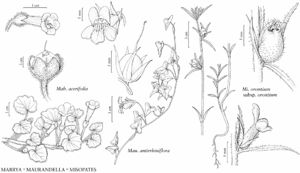Difference between revisions of "Misopates orontium subsp. orontium"
FNA>Volume Importer |
FNA>Volume Importer |
(No difference)
| |
Revision as of 18:27, 24 September 2019
Stems simple or branched, 10–70 cm. Leaves: blade linear to narrowly lanceolate or narrowly oblanceolate, 12–55 × 2–10 mm, glandular. Inflorescences 2–25 cm, densely glandular-hairy; bracts linear, 15–25 × 0.9–1.2 mm. Pedicels ascending, 0.5–2.5 mm in flower, to 4 mm in fruit. Flowers: calyx lobes accrescent, abaxial 10–15 × 1–2 mm in fruit, adaxial 15–20 × 1–2.5 mm in fruit; corolla sparsely glandular-pubescent externally, tube 6–8 mm, internally glandular-pubescent abaxially, hairs yellow, palate densely white-lanate, throat 3.5–4.5 mm diam., abaxial lip: middle lobe narrower than laterals; stamens included; staminode 0.2 mm; style persistent, densely glandular-pubescent. Capsules obliquely ovoid or oblong-ovoid, 4–7 mm wide, glandular-pubescent. Seeds 0.9–1.2 mm, papillate, abaxial face keeled, adaxial with sinuate marginal ridges, wings narrow. 2n = 16 (Portugal).
Phenology: Flowering May–Oct.
Habitat: Disturbed sites, including roadsides, rail yards, construction sites, abandoned areas, gravel bars.
Elevation: 0–1000 m.
Distribution
B.C., Ont., Que., Alaska, Calif., Conn., Fla., Idaho, Ill., Ky., Maine, Mich., N.J., N.Y., Ohio, Oreg., Pa., Utah, Va., Wash., Europe, Asia, n Africa, introduced also in South America (Argentina, Bolivia, Ecuador), s Africa (Republic of South Africa), Pacific Islands (Hawaii, New Zealand), Australia.
Discussion
Subspecies orontium is widely, sporadically naturalized, mostly in temperate regions of the world.
Selected References
None.
